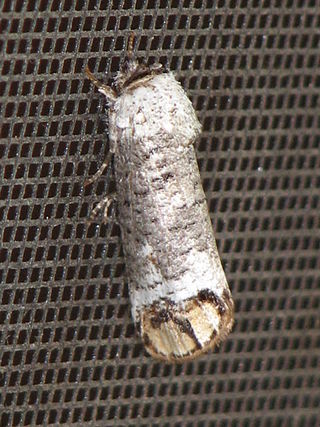
The Cossidae, the cossid millers or carpenter millers, make up a family of mostly large miller moths. This family contains over 110 genera with almost 700 known species, and many more species await description. Carpenter millers are nocturnal Lepidoptera found worldwide, except the Southeast Asian subfamily Ratardinae, which is mostly active during the day.
Culama alpina is a moth in the family Cossidae. It was described by Kallies and D.J. Hilton in 2012. It is found in Australia, where it has been recorded from Tasmania, Victoria, New South Wales and the Australian Capital Territory. The habitat consists of alpine heath and snow gum woodlands.

Culama suffusca is a moth in the family Cossidae. It was described by Kallies and D.J. Hilton in 2012. It is found in Australia, where it has been recorded from southern Victoria, northern New South Wales, Tasmania and the Australian Capital Territory. The habitat consists of wet sclerophyll forests.

Culama crepera is a moth in the family Cossidae. It was described by Turner in 1939. It is found in Australia, where it has been recorded from southern Western Australia, through South Australia to western-central Victoria and New South Wales.
Macrocyttara pamphaea is a moth in the family Cossidae. It was described by Turner in 1945. It is found in Australia, where it has been recorded from Queensland, South Australia, the Northern Territory, New South Wales and Victoria. The habitat consists of dry woodland.
Cossodes is a monotypic moth genus in the family Cossidae. Its sole species, Cossodes lyonetii, is found in south-western Western Australia.
Zyganisus cadigalorum is a moth in the family Cossidae. It is found in Australia, where it has been recorded from the Sydney area.

Zyganisus propedia is a moth in the family Cossidae. It is found in Australia, where it has been recorded from Victoria, South Australia and southern Western Australia. The habitat consists of lowland coastal forests, dry forests and heathland.
Zyganisus acalanthis is a moth in the family Cossidae. It is found in Australia, where it has been recorded from southern Western Australia.
Sympycnodes tripartita is a species of moth of the family Cossidae. It is found in Australia, where it has been recorded from northern New South Wales to southern Queensland where it occurs at altitudes up to 1,000 meters.
Endoxyla bipustulata is a moth in the family Cossidae. It is found in Australia, where it has been recorded from Queensland and South Australia.
Endoxyla opposita is a moth in the family Cossidae. It is found in Australia, where it has been recorded from Queensland, Victoria and New South Wales.
Endoxyla secta is a moth in the family Cossidae. It is found in Australia, where it has been recorded from Queensland, South Australia and Western Australia.
Endoxyla macleayi is a moth in the family Cossidae. It is found in Australia, where it has been recorded from New South Wales and southern Queensland.
Endoxyla nephocosma is a moth in the family Cossidae. It is found in Australia, where it has been recorded from Queensland and Northern Australia.
Endoxyla neuroxantha is a moth in the family Cossidae. It is found in Australia, where it has been recorded from Queensland, New South Wales and South Australia.
Endoxyla polyploca is a moth in the family Cossidae. It is found in Australia, where it has been recorded from Queensland and Northern Australia.
Endoxyla punctifimbria is a moth in the family Cossidae. It is found in Australia, where it has been recorded from Queensland, Western Australia and South Australia.
Endoxyla tenebrifer is a moth in the family Cossidae. It is found in Australia, where it has been recorded from Queensland.
Endoxyla vittata, the orange-lined wood moth, is a moth in the family Cossidae. It is found in Australia, where it has been recorded from Western Australia.



